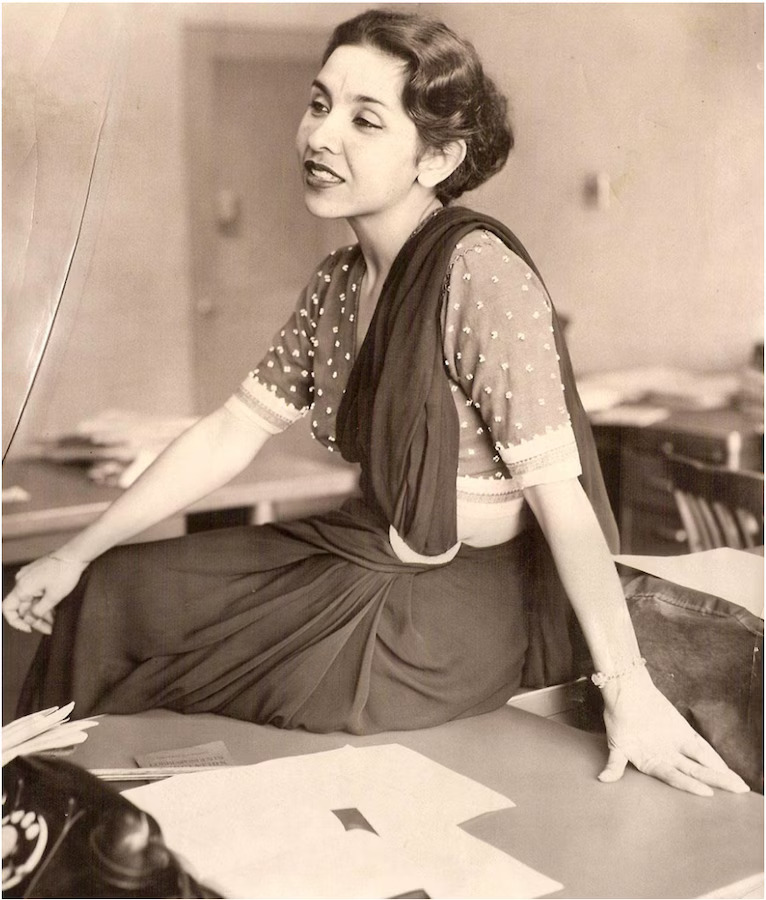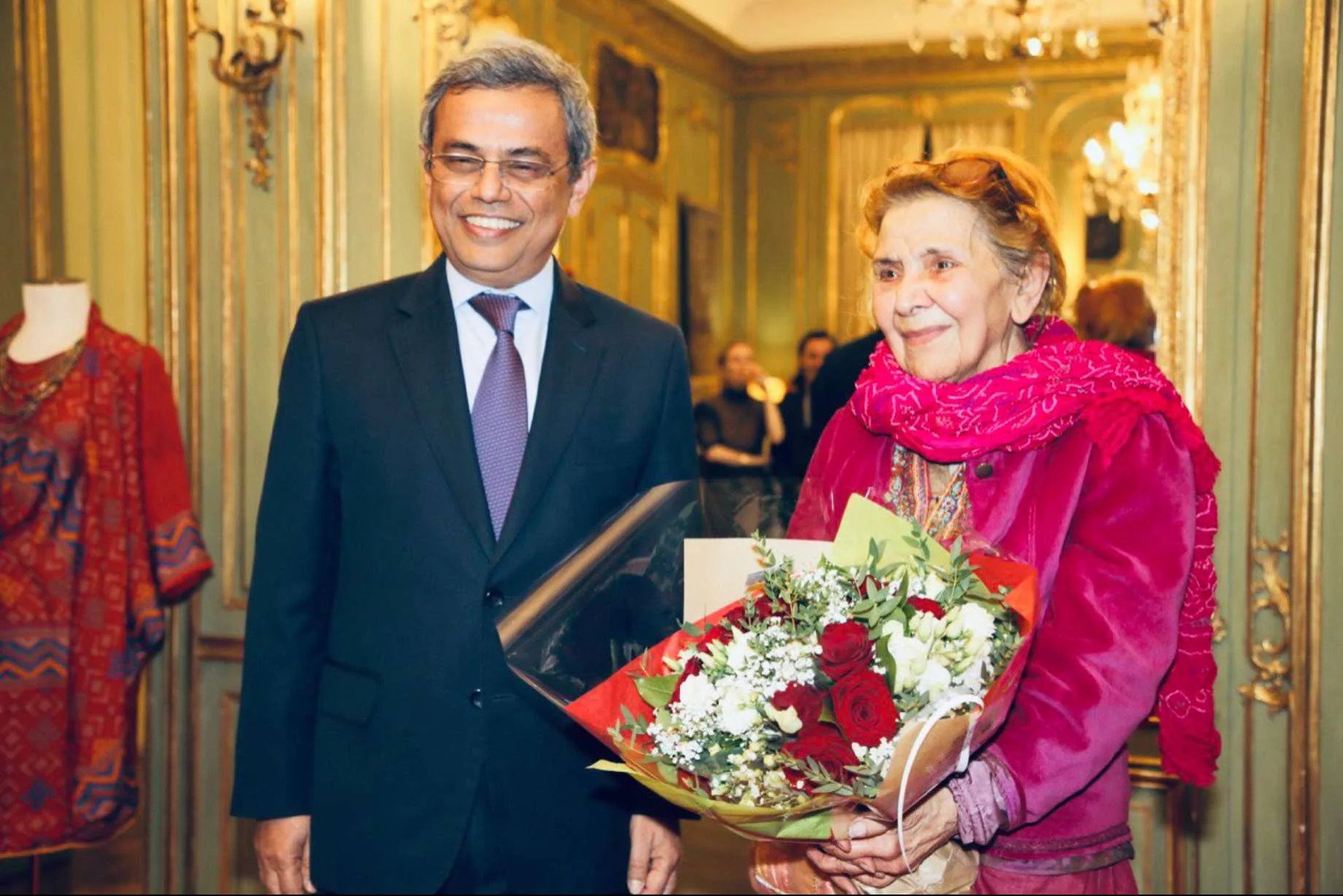(November 5, 2023) On Rue 21 St Sulpice, an upscale district in Paris, thronged by thousands of visitors drawn to the 400-year-old church, local pubs, cafes, and shops, one store stands out – Mohanjeet. As the oldest establishment on the street, Mohanjeet exudes a nostalgic charm, with its window displays reminding one of a bygone era. While the fashion capital of the world continually introduces new styles and chic designs, this 51-year-old atelier possesses an allure that few others in the vicinity can match. And the persona behind this is 92-year-old Mohanjeet Grewal who introduced Paris to Indian fashion as early as the 1960s.
Like many Hindu families who boarded trains or walked for miles to cross over to India a day ahead of Partition, Mohanjeet’s family too packed the bare minimum and made their way from Lahore to Patiala to start their life afresh. Her father, who was the Director of Education in Patiala, motivated a young Mohanjeet to follow her heart and dreams. This led her to winning a scholarship in 1952 and she boarded her first flight to the US to pursue her master’s in Political Science at the University of California, Los Angeles. In love with the new city and her studies, she followed this up with a PhD at the University of California, Berkeley. “I owe the urge to gain higher knowledge to my father. He was so passionate about education, and this was the greatest gift he gave me,” she said in an interview.

Mohanjeet Grewal
Still a student, she worked as a guide with the United Nations. But it was journalism that intrigued her and after finishing her studies, she started working as a journalist with the now defunct New York Tribune and later with the New York Times, which she recalls as a “really exciting” time. Keen to learn and expand her horizons, she moved to Vienna to work at the International Atomic Energy Agency.
Bringing Indian textiles to Paris
After a short stint, she yet again relocated to Paris to work with UNESCO. While working for them, an incident nudged her on the path of fashion. It began one fine day when someone in the US, looking at her attire – a saree – asked if she was from Israel. That’s when she realised that no one knew about India outside of UNESCO and what it had to offer, and this motivated her to do something about it. “All I wanted was to showcase and sell India’s craftsmanship to the world. I came back to rediscover India, and I was so excited by the vibrant colours of Rajasthan, the brightness and spark all around, which was in complete contrast to the blacks and the greys of the West. Even if one were to come with a mission to find something ugly in India, they would not be able to find it,” she added.
In April of 1964, she became the first Indian to set up a boutique on Rue de Bac, a legendary thoroughfare located on the left bank of Paris. Called “La Malle de l’Inde” which translates as “The Indian Trunk”, she began with the help of a 3,000 francs loan from one friend and a 7,000 francs loan from another, she brought numerous trunks filled with Indian fabrics to France. With no formal training in fashion and having never worked with sketches, she took it upon herself to make Indian craftsmanship and textiles popular in Paris.
View this post on Instagram
Boho chic became the new trend
She began with red coolie shirts and pocket vests in menswear and later introduced khadi kurtas and chikankari kurtas in various colours. Mohanjeet mostly relied on her natural talent for choosing and mixing designs. “For instance, take the mini saree I designed in 1967. I always wore sarees but I had just begun wearing minis. So, I designed the hemline of the sari, above the knee. It just happened! Likewise, I designed gold-rimmed dhotis as wraparounds to make it a globally relevant silhouette,” said Mohanjeet whose designs soon made it to the covers of French magazines.
What she brought to the fashion world in Paris was unlike ever seen. Her boho chic style soon found an audience as her popularity kept growing with each passing year. It was her creativity and personality that drew names like Romain Gary, Jean Seberg, Catherine Deneuve, Yves Saint Laurent, Jane Fonda, Princess Caroline of Monaco, and Bridget Bardot to her store regularly.

Her vision had no bounds and soon her designs made their way to Spain, Monaco, and the US, and even graced the shelves of retail chains such as Ann Taylor and Bloomingdales. Not just this, a fuscia ghagra designed by her made it to the opening fashion pages of the US edition of Vogue. During that time, she developed a friendship with Vogue’s celebrated photographer William Klein who was making a film on the fashion industry. Though the project took a few years in the making, the film Qui Etes Vous Polly Magoo (Who Are You Polly Magoo) became a cult movie of the era, and many characters in the film were seen wearing Mohanjeet’s designs.
Living the legacy
Mohanjeet describes her sense of fashion as mirroring her life, characterised by a sense of freedom. “I never followed any rules of fashion. I made sarees that I wore with collared shirts. Even when I was young, I would have different socks on each foot, visible under cuffed salwars; [I] wore abstract geometric prints and even Sikh karas instead of glass bangles,” she said.
View this post on Instagram
After taking over the global fashion market for over 50 years now, she is keen to return home and set up a store in Delhi soon. When not busy weaving magic in her store, she likes exploring Paris by visiting its museums and cinemas, apart from listening to music and dancing. “I define myself as a potter who has clay in her hands and does something out of it.”
- Follow Mohanjeet Grewal on Instagram




